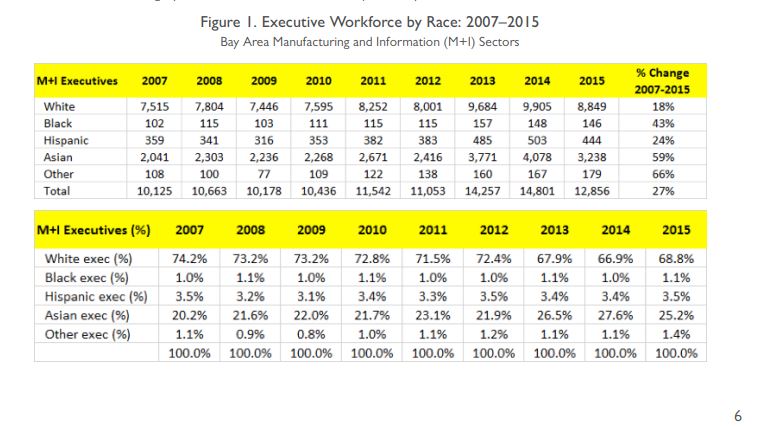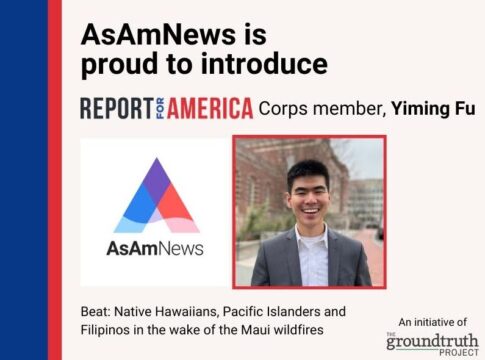By Julia Tong, AsAmNews Staff Writer
Buck Gee rose to the position of Vice President at Cisco in 2006. While proud of his accomplishment, he described himself as surprised to see he was the sole East Asian Vice President out of 104 total.
Gee’s experience inspired him to begin examining the promotion disparities in the corporate world. As a researcher for Ascend, a professional Pan-Asian business organization, he soon found that he was not alone: Asian Americans remained persistently underrepresented in corporate leadership positions, especially at the board level.
“Asian Americans are highly represented in corporate,” Gee says. “[But] it turns out, when we look at data, we’re the… least likely to be promoted to executives.”
Though Asian Americans are over represented in low paying jobs overall and higher paying jobs in the tech sector, data shows that they are the least likely of any race to be promoted into management. Ascend’s 2017 analysis of Equal Employment Opportunity data showed that Asian Americans were the least likely to become Managers and Executives across all races, despite having the largest entry-level cohort. These inequalities are magnified for Asian women, who were the least likely of all groups and genders to be promoted to the Executive levels.
LATEST STORIES
According to David Chun, the CEO of corporate governance and data firm Equilar, the lack of Asian American representation on corporate boards has significant ramifications on critical decisions. Notably, these include recruiting and hiring in all levels of the company, from management to the C suite.
“At the end of the day, a lot of big decisions are made in the boardroom, and you want to have representation,” Chun says. “If Asian voices aren’t in the room, any decisions that may affect the AAPI community— we want to make sure we have representation at the table.”

“They see my face and they see the model minority”
Gee’s research identifies three central reasons for the bamboo ceiling: a gap in awareness on the issue, the lack of Asian American leadership role models in corporate America, and cultural differences.
Stereotypes and biases about Asian Americans, Gee says, contributes to many of the difficulties Asian Americans face in the workplace.
“It’s implicit bias that if you’re Asian, you’re a good worker and not a great leader,” Gee says. He observes that these misguided perceptions create a confirmation bias effect.
These assumptions are deeply rooted in societal stereotypes of Asian people. A 2010 study by Dr. Thomas Sy, for instance, presented employees with a White and Asian candidate with identical qualifications. It found that while Asian engineers were perceived as more capable than a White engineer, an Asian salesperson was less capable that the White salesman—despite having the same qualifications.
The implicit biases surrounding Asian Americans are a product of greater dynamics surrounding Asian Americans in the US. The model minority myth, for instance, groups the notably diverse Asian diaspora into a monolith.
As a result, Asian Americans become stereotyped in similar ways—despite the significant differences in their experiences.
“[When] people see my face, they don’t know whether I’m an immigrant or American born or whatever. They see my face and they see the model minority,” he says. “We all face the same problem. People lump us as one thing.”
The lack of Asian American role models in corporate America also remains a central barrier to equity. Employees at firms have few mentors to guide them to managerial positions. Furthermore, Gee says, it reinforces the stereotype that Asian Americans are quiet and hardworking, but not leadership material.
The importance of diversity in hiring cannot be overstated, Chun argues. Having role models of a similar ethnicity to look up to can benefit both prospective recruits looking to join a company, and existing employees looking to climb the ranks.
“When [people are] considering a company they will look at the leadership of the company. Are there women in leadership and on the board? Are there people of color in leadership and on the board?” he says.
“And the reality is when people see people like themselves in those leadership roles, then they feel like, ‘I have a better chance at a company where there is representation versus one that there isn’t.’”
The final factor are cultural differences. Many Asian Americans are brought up to follow rules and work hard, ignoring softer skills such as networking. However, this can backfire in a corporate environment, where personal skills, connections, and a lack of humbleness are the norm.
Dave Liu has over 30 years of experience in Wall Street and Silicon Valley, and has held numerous board positions. He argues that it is critical that Asian American employees assert their needs and goals to those who manage them. He points to a Harvard Business Review study which found that more assertive personalities often received higher salaries and more promotions. (Full disclosure: Dave Liu serves on the board of directors of Asian American Media Inc, the 501c3 that publishes AsAmNews.).
“The more disagreeable you are as a man, the more you get paid,” Liu says. “And when you think about that, that runs counter to a lot of Eastern values.”
Being loud about personal goals—as well as more general topics such as Asian American board representation—is necessary for eliminating the bamboo ceiling.
Gee teaches a Harvard Business School course on executive education for AAPI leaders. He found that 48 out of 50 of the students, which included many high-ranking employees, reported the same biggest takeaway: “I need to ask for what I want.”
Gee hopes that further education and advocacy will give Asian American professionals the tools to do so in their jobs.
“[Companies are] trying to respond to what society’s asked them to do, to be more diverse. But so far, we haven’t asked them to be more diverse in terms of our leadership,” Gee says. “So first of all, they don’t know. And the related problem is we haven’t been asked before. And so because we’re asking for it, I think that we can change.”

“Let’s work together to help move the needle”
Asian Americans, however, are organizing to change the industry.
Most recently, Gold House, which describes itself as an API changemaker organization, has partnered with multiple funds to launch the Multicultural Leadership Coalition (MCL) in October 2022. The goal of the coalition is to provide a direct pipeline for leaders from underrepresented communities into Board Directors and Advisor positions on company boards. The co-founders represent over $1.5bn in assets under management.
According to Liu, efforts like the MLC are significant steps in raising awareness about what he describes as the “equity ceiling” Asian American professionals face. However, he points out that board selection is often opaque and reliant on factors such as personal connections. As a result, it can be difficult for individual efforts to institute significant industry-wide changes.
“There’s usually a whole bunch of gymnastics that occur to fit a board. It can be a combination of the CEO just saying, ‘Hey, I just want my buddies on the board. I don’t want anybody that is going to tell me what to do,’” he observes. “That refrain has been a constant in corporate America and all across the world: ‘this board is stacked with this guy’s cronies.’”
Instead, he says, industry wide change must be incremental and cooperative. Many different groups, including Asian American CEOs and C-suite executives, investors, and regulatory bodies like NASDAQ and the New York Stock Exchange, must all work together for change. NASDAQ’s 2021 Board Diversity Rule, for instance, mandates companies to disclose the composition of their boards. Firms with fewer than 2 diverse board members must provide explanations.
However, Chun says that companies are not only responding to regulatory requirements: Public pressure has also lead them to diversify their boards. In addition to compiling data on boards across the nation, Equilar works with over 50 different diversity organizations to maintain a database of qualified individuals. This allows companies to easily recruit underrepresented candidates into their boards.
According to Chun, this type of cooperation is imperative to breaking the bamboo ceiling.
“The more that we can all work together, the better. Strength in numbers,” he says. “If you think about the Asian American community, especially from a talent perspective, it’s such a robust and growing pool of talent.”
“Let’s work together to help move the needle.”
AsAmNews is incorporated in the state of California as Asian American Media, Inc, a non-profit with 501c3 status. Check out our new TikTok account. Find additional content on Instagram, Twitter and Facebook. Please consider interning, joining our staff, or submitting a story, or making a tax-deductible donation. We are committed to the highest ethical standards in journalism. Please report any typos or errors to info at AsAmNews dot com.








